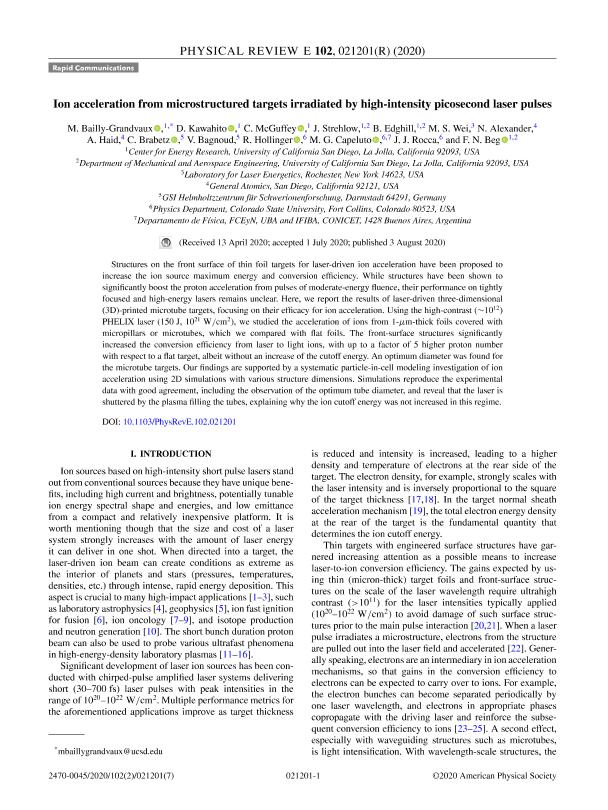Artículo
Ion acceleration from microstructured targets irradiated by high-intensity picosecond laser pulses
Bailly Grandvaux, M.; Kawahito, D.; McGuffey, C.; Strehlow, J.; Edghill, B.; Wei, M.S.; Alexander, N.; Haid, A.; Brabetz, C.; Bagnoud, V.; Hollinger, R.; Capeluto, Maria Gabriela ; Rocca, J.J.; Beg, F.N.
; Rocca, J.J.; Beg, F.N.
 ; Rocca, J.J.; Beg, F.N.
; Rocca, J.J.; Beg, F.N.
Fecha de publicación:
08/2020
Editorial:
American Physical Society
Revista:
Physical Review E
ISSN:
2470-0053
Idioma:
Inglés
Tipo de recurso:
Artículo publicado
Clasificación temática:
Resumen
Structures on the front surface of thin foil targets for laser-driven ion acceleration have been proposed to increase the ion source maximum energy and conversion efficiency. While structures have been shown to significantly boost the proton acceleration from pulses of moderate-energy fluence, their performance on tightly focused and high-energy lasers remains unclear. Here, we report the results of laser-driven three-dimensional (3D)-printed microtube targets, focusing on their efficacy for ion acceleration. Using the high-contrast (∼1012) PHELIX laser (150J, 1021W/cm2), we studied the acceleration of ions from 1-μm-thick foils covered with micropillars or microtubes, which we compared with flat foils. The front-surface structures significantly increased the conversion efficiency from laser to light ions, with up to a factor of 5 higher proton number with respect to a flat target, albeit without an increase of the cutoff energy. An optimum diameter was found for the microtube targets. Our findings are supported by a systematic particle-in-cell modeling investigation of ion acceleration using 2D simulations with various structure dimensions. Simulations reproduce the experimental data with good agreement, including the observation of the optimum tube diameter, and reveal that the laser is shuttered by the plasma filling the tubes, explaining why the ion cutoff energy was not increased in this regime.
Palabras clave:
ION ACCELERATION
,
PLASMA
,
UHED
Archivos asociados
Licencia
Identificadores
Colecciones
Articulos(IFIBA)
Articulos de INST.DE FISICA DE BUENOS AIRES
Articulos de INST.DE FISICA DE BUENOS AIRES
Citación
Bailly Grandvaux, M.; Kawahito, D.; McGuffey, C.; Strehlow, J.; Edghill, B.; et al.; Ion acceleration from microstructured targets irradiated by high-intensity picosecond laser pulses; American Physical Society; Physical Review E; 102; 2; 8-2020; 1-7
Compartir
Altmétricas



